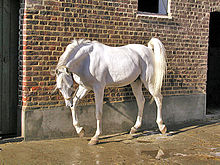
The horse is a domesticated, one-toed, hoofed mammal. It belongs to the taxonomic family Equidae and is one of two extant subspecies of Equus ferus. The horse has evolved over the past 45 to 55 million years from a small multi-toed creature, close to Eohippus, into the large, single-toed animal of today. Humans began domesticating horses around 4000 BCE, and their domestication is believed to have been widespread by 3000 BCE. Horses in the subspecies caballus are domesticated, although some domesticated populations live in the wild as feral horses. These feral populations are not true wild horses, which are horses that never have been domesticated and historically linked to the megafauna category of species. There is an extensive, specialized vocabulary used to describe equine-related concepts, covering everything from anatomy to life stages, size, colors, markings, breeds, locomotion, and behavior.
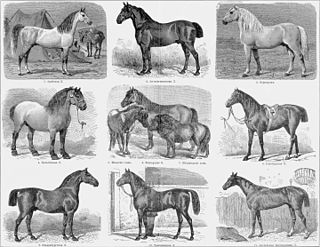
A horse breed is a selectively bred population of domesticated horses, often with pedigrees recorded in a breed registry. However, the term is sometimes used in a broader sense to define landrace animals of a common phenotype located within a limited geographic region, or even feral "breeds" that are naturally selected. Depending on definition, hundreds of "breeds" exist today, developed for many different uses. Horse breeds are loosely divided into three categories based on general temperament: spirited "hot bloods" with speed and endurance; "cold bloods," such as draft horses and some ponies, suitable for slow, heavy work; and "warmbloods," developed from crosses between hot bloods and cold bloods, often focusing on creating breeds for specific riding purposes, particularly in Europe.
Horse breeding is reproduction in horses, and particularly the human-directed process of selective breeding of animals, particularly purebred horses of a given breed. Planned matings can be used to produce specifically desired characteristics in domesticated horses. Furthermore, modern breeding management and technologies can increase the rate of conception, a healthy pregnancy, and successful foaling.
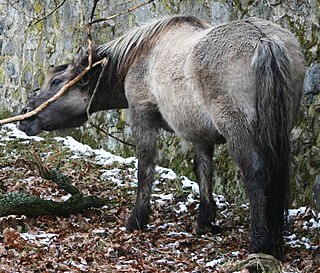
How and when horses became domesticated has been disputed. Although horses appeared in Paleolithic cave art as early as 30,000 BC, these were wild horses and were probably hunted for meat. The clearest evidence of early use of the horse as a means of transport is from chariot burials dated c. 2000 BC. However, an increasing amount of evidence began to support the hypothesis that horses were domesticated in the Eurasian Steppes in approximately 3500 BC. Discoveries in the context of the Botai culture had suggested that Botai settlements in the Akmola Province of Kazakhstan are the location of the earliest domestication of the horse. Warmouth et al. (2012) pointed to horses having been domesticated around 3000 BC in what is now Ukraine and Western Kazakhstan.

The Akhal-Teke is a Turkmen horse breed. They have a reputation for speed and endurance, intelligence, and a distinctive metallic sheen. The shiny coat of the breed led to their nickname, "Golden Horses". These horses are adapted to severe climatic conditions and are thought to be one of the oldest existing horse breeds. There are currently about 6,600 Akhal-Tekes in the world, mostly in Turkmenistan, although they are also found throughout Europe and North America. Akhal is the name of the line of oases along the north slope of the Kopet Dag mountains in Turkmenistan. It has been inhabited by the Tekke tribe of Turkmens.

Warmbloods are a group of middle-weight horse types and breeds primarily originating in Europe and registered with organizations that are characterized by open studbook policy, studbook selection, and the aim of breeding for equestrian sport. The term distinguishes these horses from both heavy draft horses and refined light saddle horses such as the Thoroughbred, Arabian, and Akhal-Teke. Although modern warmbloods are descended from heavier agricultural types systematically upgraded by hotblood influence, the term does not imply that warmbloods are direct crosses of "cold" and "hot".

The Arabian or Arab horse is a breed of horse with historic roots on the Arabian Peninsula. With a distinctive head shape and high tail carriage, the Arabian is one of the most easily recognizable horse breeds in the world. It is also one of the oldest modern breeds. Although modern DNA cannot trace breed purity in the modern population beyond 200 years, there is archaeological evidence of horses in the Middle East with landrace characteristics that resemble modern Arabians dating back 3,500 years. Throughout history, Arabian horses have spread around the world by both war and trade, used to improve other breeds by adding speed, refinement, endurance, and strong bone. Today, Arabian bloodlines are found in almost every modern breed of riding horse.

The Konik or Polish Konik is a Polish breed of pony. There are semi-feral populations in some regions. They are usually mouse dun or striped dun in color.

The Percheron is a breed of draft horse that originated in the Huisne river valley in western France, part of the former Perche province, from which the breed takes its name. Usually gray or black in color, Percherons are well-muscled, and known for their intelligence and willingness to work. Although their exact origins are unknown, the ancestors of the breed were present in the valley by the 17th century. They are believed to descend from war horses. Over time, they began to be used for pulling stagecoaches; and later, for agriculture and hauling heavy goods. In the late 18th and early 19th centuries, Arabian blood was added to the breed. Exports of Percherons from France rose exponentially in the late 19th century, and the first purely Percheron stud book was created in France in 1893.

The Iberian horse is a designation given to a number of horse breeds native to the Iberian peninsula. At present, some breeds are officially recognized by the FAO, while other horses believed to be native to the peninsula are not. Likewise, some modern breeds are understood from mitochondrial DNA to be descended from historic landraces, while others have origins outside the Iberian peninsula. The remaining FAO-recognized breeds are of well-known foreign blood, or are recently developed breeds.

The Lusitano, also known as the Pure Blood Lusitano or PSL, is a Portuguese horse breed. Horses were known to be present on the Iberian Peninsula as far back as 20,000 BC, and by 800 BC the region was renowned for its war horses. The fame of the horses from Lusitania goes back to the Roman Age, which attributed its speed to the influence of the West wind, who was considered capable of fertilizing the mares. When the Muslims invaded Iberia in 711 AD, they brought Arabian horses with them that were crossed with the native horses, developing a horse that became useful for war, dressage and bull fighting. The Portuguese horse was named the Lusitano, after the word Lusitania, the ancient Roman name for the region that modern Portugal occupies. There are four main breed lineages within the breed today, and characteristics differ slightly between each line.

The Exmoor Pony is a British breed of pony or small horse. It is one of the mountain and moorland pony breeds native to the British Isles, and so falls within the larger Celtic group of European ponies. It originates on, and is named for, the Exmoor area of moorland in north-eastern Devon and western Somerset, in south-west England, and is well adapted to the climate conditions and poor grazing of the moor. Some still live there in a near-feral state, but most are in private ownership.

The Sorraia is a rare breed of horse indigenous to the portion of the Iberian peninsula, in the Sorraia River basin, in Portugal. The Sorraia is known for its primitive features, including a convex profile and dun coloring with primitive markings. Concerning its origins, a theory has been advanced by some authors that the Sorraia is a descendant of primitive horses belonging to the naturally occurring wild fauna of Southern Iberia. Studies are currently ongoing to discover the relationship between the Sorraia and various wild horse types, as well as its relationship with other breeds from the Iberian Peninsula and Northern Africa.
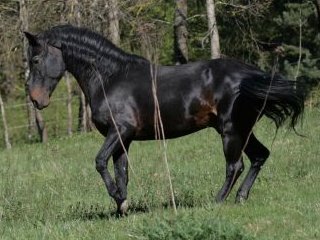
The Kabarda, Kabardin or Circassian horse is a breed from the Caucasus, originating from Eastern Circassia, currently part of the Kabardino-Balkaria region of Russia. These horses are noted for their endurance and ease to adapt in difficult environments.

The Boulonnais, also known as the "White Marble Horse", is a draft horse breed. It is known for its large but elegant appearance and is usually gray, although chestnut and black are also allowed by the French breed registry. Originally there were several sub-types, but they were crossbred until only one is seen today. The breed's origins trace to a period before the Crusades and, during the 17th century, Spanish Barb, Arabian, and Andalusian blood were added to create the modern type.
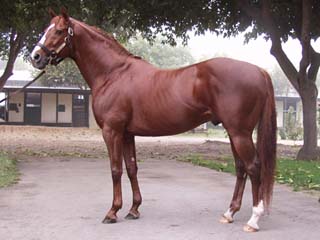
The Thoroughbred is a horse breed developed for horse racing. Although the word thoroughbred is sometimes used to refer to any breed of purebred horse, it technically refers only to the Thoroughbred breed. Thoroughbreds are considered "hot-blooded" horses that are known for their agility, speed, and spirit.

A pony is a type of small horse. Depending on the context, a pony may be a horse that is under a given height at the withers, or a small horse with a specific conformation and temperament. Compared to a larger horse, a pony may have a thicker coat, mane and tail, with proportionally shorter legs, a wider barrel, heavier bone, a thicker neck and a shorter, broader head. The word pony derives from the old French poulenet, meaning foal, a young, immature horse.
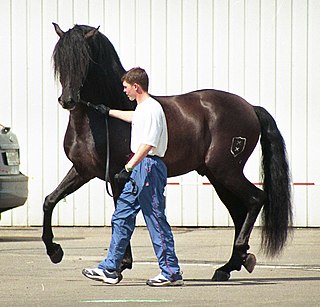
The Andalusian, also known as the Pure Spanish Horse or PRE, is a horse breed from the Iberian Peninsula, where its ancestors have lived for thousands of years. The Andalusian has been recognized as a distinct breed since the 15th century, and its conformation has changed very little over the centuries. Throughout its history, it has been known for its prowess as a war horse, and was prized by the nobility. The breed was used as a tool of diplomacy by the Spanish government, and kings across Europe rode and owned Spanish horses. During the 19th century, warfare, disease and crossbreeding reduced herd numbers dramatically, and despite some recovery in the late 19th century, the trend continued into the early 20th century. Exports of Andalusians from Spain were restricted until the 1960s, but the breed has since spread throughout the world, despite their low population. In 2010, there were more than 185,000 registered Andalusians worldwide.
The history of horse domestication has been subject to much debate, with various competing hypotheses over time about how domestication of the horse occurred. The main point of contention was whether the domestication of the horse occurred once in a single domestication event, or that the horse was domesticated independently multiple times. The debate was resolved at the beginning of the 21st century using DNA evidence that favored a mixed model in which domestication of the stallion most likely occurred only once, while wild mares of various regions were included in local domesticated herds.
